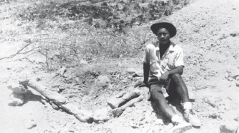

 Geodiversitas
29 (4) - Pages 549-560
Geodiversitas
29 (4) - Pages 549-560Except for some rare exceptions, the arrangement of the carpus remains poorly understood among sauropodomorphs, mainly because of a bad preservation in the fossil record. When preserved, it is difficult to identify the carpal elements, which are rarely found in articulation. Whereas the carpus of Prosauropoda is relatively well known by the remains of Massospondylus and Plateosaurus, the structure of the sauropod carpus is still unknown and subject to many interpretations so far. Here, we redescribe the manus and the wrist of ?Bothriospondylus madagascariensis, a Bathonian (Middle Jurassic) sauropod from the Majunga Basin in Madagascar, previously described by Lavocat in 1955. The wrist consists of five carpal elements, an unusual disposal among sauropods, which typically preserves most of the time three or fewer carpal bones. Moreover, these five carpal elements are arranged in three carpal rows, another unexpected feature regarding to other sauropods. The comparison of the Malagasy carpus with that of an hypothetical basal archosaur leads us to propose a new hypothesis of homology for the carpus of ?Bothriospondylus. Therefore, this specimen would consist in: a radiale, the fused distal carpal 1 with the intermedium and one or two centrales, and three distal elements (distal carpal 2, distal carpal 3, and distal carpal 4 or distal carpal 4 + ulnare).
Dinosauria, Sauropoda, carpus, manus, homology